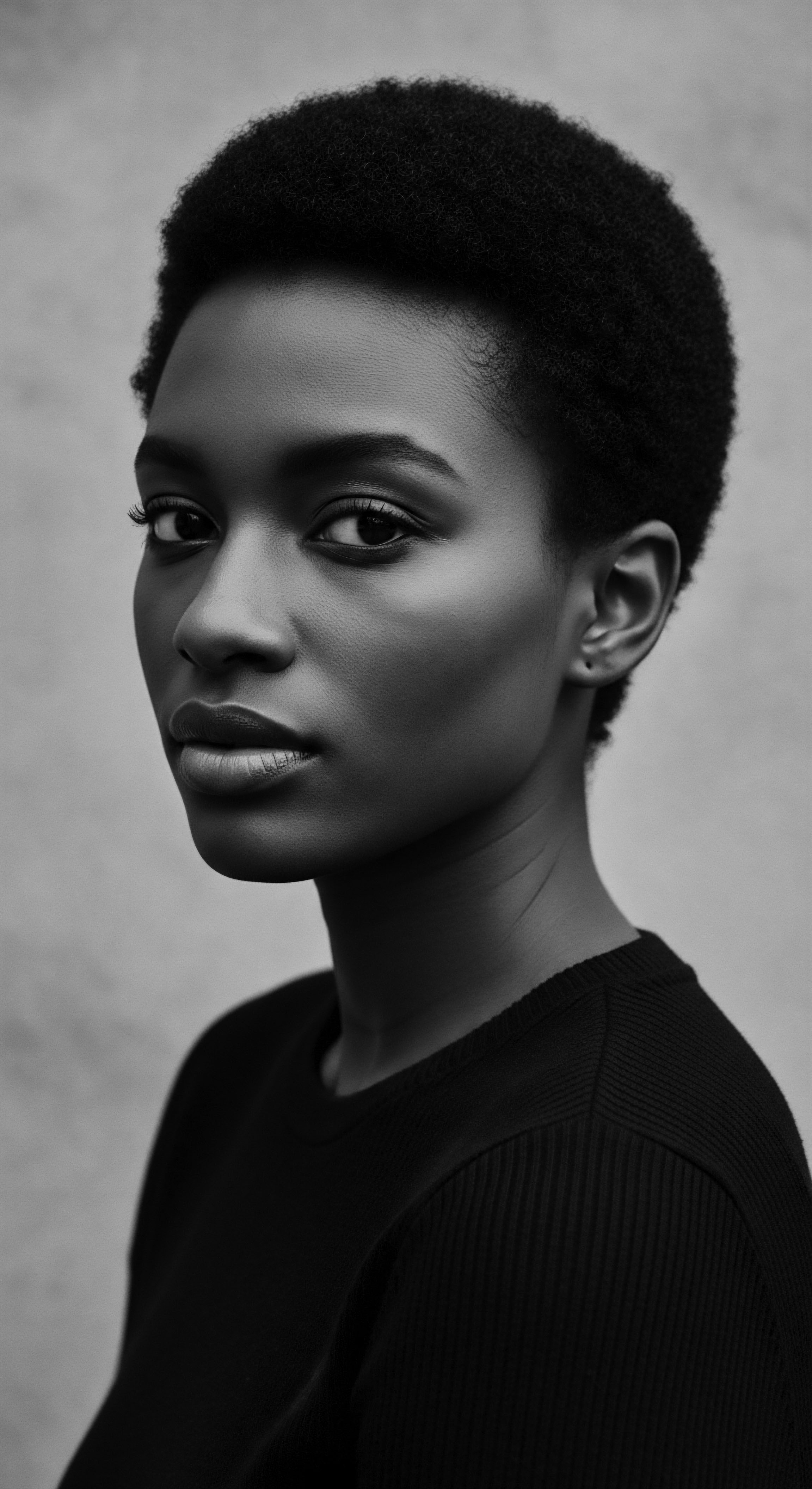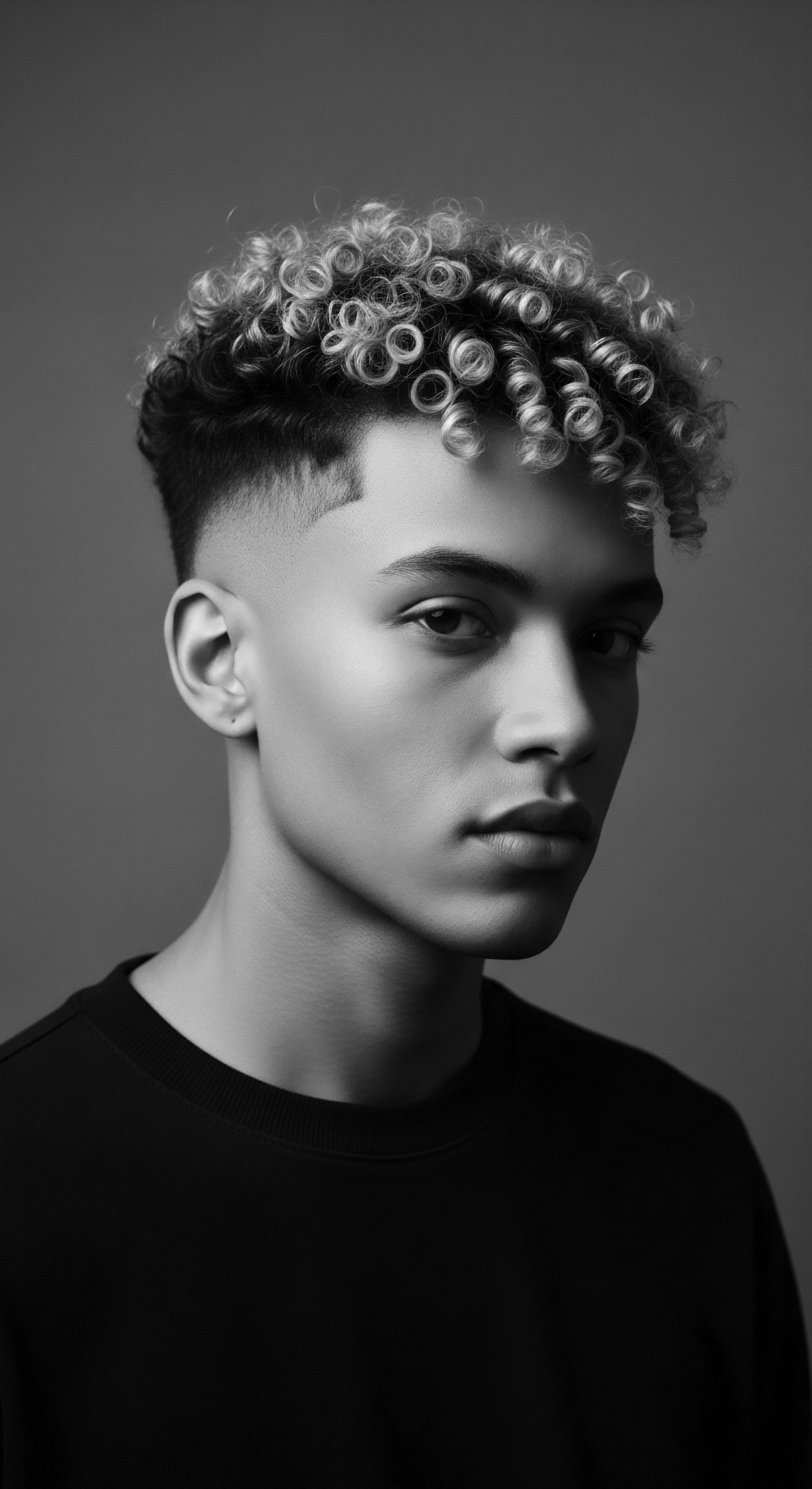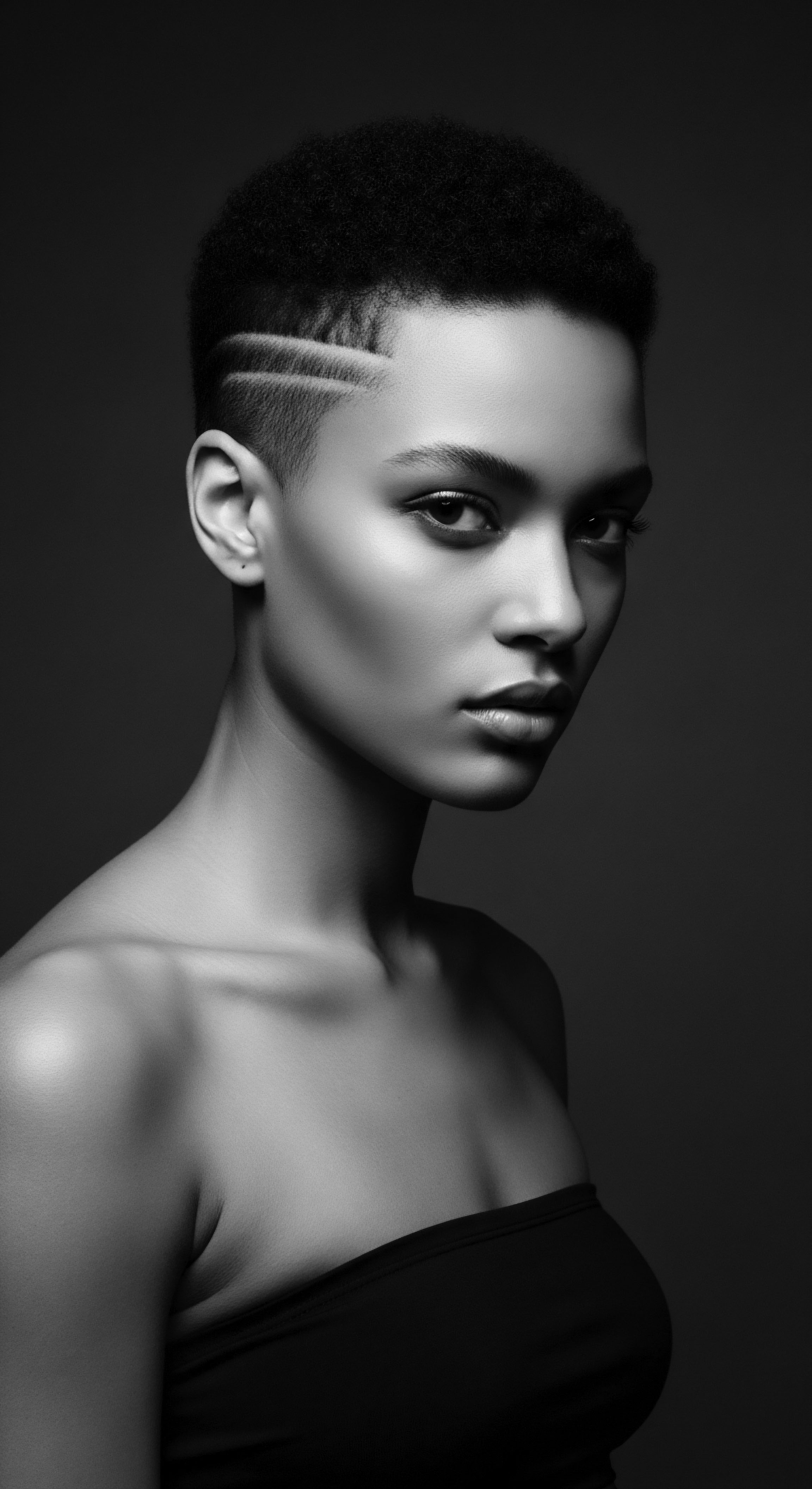
Roots
To hold a strand of textured hair in one’s hand is to hold a whisper from the soil, a testament to time, and a living archive of human heritage. It carries within its coils and bends stories older than recorded history, practices shaped by land, sun, and generations of hands. When we consider the remarkable earth-born substance known as rhassoul clay, its historical significance for hair traditions, particularly those of textured hair, begins to unfold not as a mere beauty product, but as an elemental connection to ancestral wisdom.
From the sun-baked plains of North Africa, specifically the Atlas Mountains of Morocco, comes this fine, reddish-brown mineral. Its very name, Rhassoul, or sometimes Ghassoul, echoes its purpose, stemming from the Arabic verb “rassala,” which means “to wash”. For centuries, before the concept of modern shampoos took hold, communities here relied on this natural gift for cleansing and care.
The clay itself is a geological marvel, a lacustrine sedimentary formation of Tertiary age, born from the alteration of volcanic rocks. It is here, within these ancient deposits, that its inherent power for textured hair finds its origin.

What Minerals Define This Ancient Cleanser?
The exceptional properties of rhassoul clay lie within its distinctive mineral composition, a blend that distinguishes it from other clays found around the world. It is a powerhouse of naturally occurring elements, each contributing to its profound effects on hair and scalp. Silicon makes up a substantial portion, nearly 60%, and Magnesium around 25%.
Other significant minerals include Aluminum, Calcium, Sodium, Iron, Potassium, Zinc, and Phosphorus. This mineral richness is not accidental; it is the very bedrock of rhassoul’s cleansing, detoxifying, and softening capabilities, especially for hair that thrives on gentle yet thorough purification.
Rhassoul clay, deeply rooted in North African heritage, carries a historical role as an ancestral cleanser for textured hair.
The negative charge of rhassoul clay minerals is crucial to its efficacy. This magnetic quality allows it to attract and bind to positively charged impurities, excess oils, and accumulated product residue on the scalp and hair strands. When rinsed away, these unwanted particles are carried with the clay, leaving the hair clean without stripping away its vital natural oils.
This particularity is why rhassoul clay became a staple for hair washing long before synthetic detergents arrived, preserving the natural moisture balance so crucial for the health and vitality of textured hair. Its ability to absorb sebum without disrupting the scalp’s hydrolipidic film was a natural wisdom, allowing for cleansed hair that did not feel dry or brittle.

How Did Humanity Cleanse Before Modern Soaps?
The concept of personal hygiene and hair cleansing stretches back thousands of years, far predating the commercial shampoos we recognize today. Ancient civilizations, guided by the resources of their local environments, devised ingenious methods to purify and adorn their hair. Before rhassoul clay became a cherished component of North African rituals, other communities around the globe utilized a diversity of natural elements. In ancient Egypt, for instance, people turned to oils, fats, and even citrus juices for cleansing and conditioning.
The Greeks and Romans employed vinegar rinses. In India, the Ayurvedic tradition held practices dating back to the 14th century BC, utilizing herbal pastes made from Reetha (Indian soapberry), Amla (gooseberry), and Shikakai (acacia) to nourish the scalp and hair.
Clays, in their various forms, were a recurring theme across different cultures. In ancient Greece and Rome, white clay, sometimes volcanic ash, absorbed oils from skin and hair. Native American traditions embraced ingredients such as Yucca Root for cleansing. The collective human experience with hair care demonstrates a shared ancestral knowledge of the land’s offerings, adapting to what was available to maintain cleanliness and health.
This deep history provides a backdrop for understanding the profound significance of rhassoul clay, not as an isolated phenomenon, but as a distinguished member of a global legacy of natural hair care. Its sustained usage for centuries underscores its efficacy and gentleness, particularly advantageous for the unique structural needs of textured hair.

Ritual
The journey of rhassoul clay extends beyond its geological origins into the heart of living traditions, especially those interwoven with textured hair. For generations in North Africa, particularly among Berber women, this clay transcended a simple cleansing agent. It became a ritual, a thread connecting daily care to cultural identity and ancestral practices. Its usage was a carefully handed-down wisdom, a testament to the deep respect held for natural elements and their capabilities.

What Traditional Practices Surround Rhassoul Clay for Hair?
In the landscapes of Morocco, rhassoul clay was and remains an essential component of the famed Hammam experience, a communal ritual of purification and wellness. Within these sacred spaces, rhassoul clay is applied from head to toe, its earthy essence cleansing and softening the entire body. For hair, it traditionally serves as a natural shampoo and conditioner, working harmoniously with textured coils and curls.
The process itself is deliberate, almost meditative. Raw, untreated rhassoul powder is washed, sometimes filtered, and then often mixed with local herbs and botanicals.
Consider the customary preparation:
- Orange Blossom Water ❉ Often used to mix with the clay, lending a delicate scent and additional conditioning properties.
- Lavender ❉ Included for its calming aroma and potential soothing effects on the scalp.
- Myrtle ❉ A traditional botanical that contributes to the clay mixture, reflecting an intimate knowledge of local flora.
- Chamomile ❉ Added for its gentle nature, particularly beneficial for sensitive scalps.
This bespoke blending of earth and plant illustrates a holistic approach to hair care, acknowledging the interplay of environment, sensory experience, and physical well-being.

How Does Ancestral Preparation Enhance Hair Health?
The traditional preparation of rhassoul clay for hair care speaks volumes about the ancestral understanding of hair health. Rather than aggressive stripping, the method prioritizes a gentle, yet effective, cleansing. The clay’s soft, silky texture when moistened allows for smooth application, gliding through textured hair without causing undue friction or tangling.
This is particularly significant for coily and kinky hair types, which are inherently more prone to dryness and breakage. The clay’s ability to absorb excess sebum and impurities while leaving the hair’s protective lipid layer intact is a critical benefit for these hair textures.
Traditional rhassoul clay rituals prioritize gentle cleansing and scalp health, reflecting deep ancestral knowledge of textured hair needs.
Moreover, the practice often involved massaging the clay mixture into the scalp, stimulating circulation and ensuring the cleansing minerals reached the hair follicles. This careful application, often followed by a period of rest before rinsing, allowed the clay to perform its work of drawing out impurities and depositing beneficial minerals. The result was not merely clean hair, but hair that retained its natural moisture, felt soft, and possessed a healthy sheen.
This ancestral methodology contrasts sharply with the harsh, sulfate-laden cleansers that became common in modern eras, which often proved detrimental to the delicate nature of textured hair. The wisdom of preserving the hair’s natural state was a cornerstone of these traditional rituals.

Relay
The enduring story of rhassoul clay transcends time, its ancient wisdom continuing to resonate with contemporary understanding of hair health, particularly for those with textured hair. What began as a local, inherited practice now finds validation in scientific inquiry, bridging the gap between ancestral knowledge and modern discovery. This clay, once a secret of the Atlas Mountains, reveals its complex capabilities, offering a compelling narrative of how our heritage continues to guide us toward holistic well-being.

Does Modern Science Validate Ancient Clay Practices?
Scientific exploration into rhassoul clay confirms what generations of North African communities have understood intuitively ❉ its properties are remarkably suited for gentle yet effective cleansing. The clay’s significant content of Silica, Magnesium, and other minerals contributes directly to its beneficial effects. Silica, for instance, is known to strengthen hair shafts and promote elasticity, helping to reduce breakage common in textured hair. Magnesium assists in soothing irritated scalps and can support hair growth.
The clay’s ability to absorb oils and impurities without stripping the hair’s natural moisture barrier is attributed to its high absorption and cation-exchange capacities, a mechanism that essentially acts like a magnet for toxins. This gentle detoxification respects the scalp’s natural pH balance, a critical aspect often compromised by harsh synthetic shampoos.
The persistence of rhassoul clay in modern natural hair care movements, especially within Black and mixed-race communities, reflects a conscious reclamation of ancestral practices. Many individuals are turning away from conventional products that may contain ingredients detrimental to textured hair, seeking instead the gentle effectiveness of natural alternatives. The understanding that this clay cleanses without disrupting the hair’s natural oils or causing excessive dryness aligns perfectly with the needs of diverse textured hair types, which often require careful moisture retention.
| Historical Application Used as a natural shampoo in North African hammam rituals. |
| Contemporary Scientific Understanding & Benefits Acts as a gentle, mineral-rich cleanser, absorbing excess sebum and impurities without stripping natural oils, due to its high absorption and cation-exchange properties. |
| Historical Application Mixed with traditional herbs like lavender and orange blossom water for hair washes. |
| Contemporary Scientific Understanding & Benefits Minerals like silica and magnesium strengthen hair strands, promote elasticity, and soothe the scalp, contributing to overall hair health and reduced breakage. |
| Historical Application Applied for cleansing and conditioning, especially for thick, textured hair. |
| Contemporary Scientific Understanding & Benefits Helps maintain scalp pH balance, prevents dandruff, and leaves hair soft and manageable, which is particularly beneficial for the delicate nature of textured hair. |
| Historical Application The enduring utility of rhassoul clay speaks to a continuous thread of wisdom connecting ancient care practices with modern scientific validation for textured hair heritage. |

How Does Clay Connect to Ancestral Hair Styles?
Beyond cleansing, rhassoul clay finds its place within the broader context of ancestral hair care and styling, specifically linked to communities with textured hair. A compelling historical example that illuminates clay’s deep connection to textured hair heritage comes from the Himba Tribe of Namibia. These pastoralist people are renowned for their distinctive hair rituals, involving the application of a paste called Otjize, a mixture of butterfat, ochre pigment, and sometimes aromatic resins and herbs (Malan, 1995). While not rhassoul clay specifically, this practice showcases a tradition where earth-derived substances are fundamental to hair care, protection, and cultural identity.
The Himba women’s hair, often in elaborate dreadlock-like styles, is coated with otjize to protect it from the harsh environment and signify their age and status. This centuries-old practice is not merely cosmetic; it is deeply entwined with their spiritual beliefs, social structure, and connection to the land. It stands as a powerful testament to how clay and earth pigments have been integral to the preservation, styling, and cultural expression of textured hair across different African communities for millennia. This example, alongside the extensive use of rhassoul clay in North Africa, underscores a widespread ancestral understanding of natural ingredients for both protection and adornment of hair, emphasizing the enduring relevance of these traditions.
Rhassoul clay embodies a continuous dialogue between ancient practices and modern scientific understanding of textured hair wellness.
The connection between rhassoul clay and protective styling is subtle, yet significant. When textured hair is cleansed gently, as rhassoul clay allows, it retains its natural moisture, becoming less prone to breakage when styled into protective forms like braids, twists, or coils. The clay’s ability to remove buildup without stripping further prepares the hair for these styles, ensuring scalp health is maintained beneath the protective structure. This holistic approach, from cleansing to styling, reflects a deep-seated respect for the resilience and beauty of textured hair, echoing a wisdom passed down through generations.

Reflection
The story of rhassoul clay, as it pertains to textured hair heritage, is a profound echo from the source, a living testament to the enduring wisdom of ancestral practices. It is a reminder that beauty, in its most genuine form, often lies in the earth beneath our feet and the generations of knowledge that preceded us. This earthy treasure, born from the Atlas Mountains, continues to tell a story of care, community, and identity, woven into the very strands we nurture today.
The legacy of rhassoul clay is more than a historical footnote; it is a current, vital component of how many approach their textured hair with reverence and intention. It symbolizes a return to simpler, yet deeply effective, methods that honor the inherent biology of hair and the cultural richness of its adornment. To use rhassoul clay is to partake in a continuous narrative, acknowledging the resilience of traditions and the beauty found in natural, earth-given resources.
It is to recognize that the care for our textured hair is not merely a routine, but a sacred act, a connection to the ‘Soul of a Strand’ that vibrates with the stories of those who came before us. This clay, silent yet potent, offers a path to rediscovering the inherent strength and radiance of our hair, grounded in the enduring heritage of the earth itself.

References
- Malan, J. S. (1995). The Himba of Namibia ❉ A study of the changes in their culture and way of life. Van Schaik.
- Gomes, C. S. F. & Silva, J. C. (2009). Minerals in cosmetics ❉ A historical perspective and current applications. Earth-Science Reviews, 96(3), 199-214.
- Chaudhri, S. & Jain, N. K. (2009). History of cosmetics. Asian Journal of Pharmacy and Life Science, 2(2), 241-248.
- Martel, M. (2009). The ancient world of beauty ❉ From Cleopatra to the Renaissance. New York ❉ Abrams.
- Lambert, E. (2001). Hair story ❉ Untangling the roots of Black hair in America. St. Martin’s Press.
